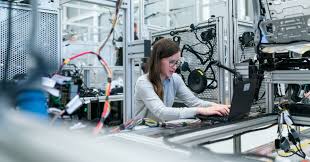
Introduction
Few inventions have had as much of an impact on contemporary engineering and scientific research as vacuum technology. Vacuum technology finds new uses in a wide range of fields, from enabling groundbreaking research endeavors to enabling manufacturing process advancements. This article explores the many applications, underlying theories, and unrivaled advantages that vacuum technology provides to a range of sectors, delving deeply into the complexities of the field.
Understanding Vacuum Technology
Demystifying the Basics
Vacuum technology, sometimes known as vacuum engineering, is the study and application of vacuum settings for a variety of uses. Fundamentally, it’s about creating and maintaining areas that are empty of stuff, which is usually accomplished by using specialized equipment like vacuum pumps to remove air and other gases.
Principles at Play
The fundamental idea of vacuum technology is negative pressure, which states that the pressure inside a closed enclosure is lower than the surrounding air. The operation of vacuum systems is based on this fundamental idea, which also powers operations such as material deposition in semiconductor manufacture and vacuum packaging for the preservation of perishable items.
Uses in Various Industries: Producing Marvels
Vacuum technology is essential to many production processes, ranging from surface treatment and precise coating to the synthesis of cutting-edge materials. It is vital to sectors including electronics, automotive, and aerospace because of its capacity to provide regulated, pollutant-free environments.
Scientific Frontiers
In scientific research, vacuum technology serves as an indispensable tool for experimentation and discovery. From the study of particle physics in high-energy accelerators to the investigation of atomic structures using electron microscopes, vacuum environments provide the pristine conditions necessary for elucidating the mysteries of the universe.
Innovations Driving Progress
Advancements in Vacuum Pump Technology
Recent years have witnessed significant advancements in vacuum pump technology, leading to the development of more efficient, compact, and environmentally sustainable systems. Innovations such as dry vacuum pumps and turbomolecular pumps have revolutionized industrial processes, offering enhanced performance and reliability.
Miniaturization and Portability
The miniaturization of vacuum components has paved the way for portable vacuum devices, enabling applications in diverse fields such as medical diagnostics, consumer electronics, and environmental monitoring. These compact systems provide unparalleled versatility and accessibility, empowering researchers and engineers to explore new frontiers.
Challenges and Future Prospects
Overcoming Technical Hurdles
Despite its myriad benefits, vacuum technology is not without its challenges. Issues such as pump contamination, vacuum leaks, and material outgassing pose significant hurdles in certain applications. However, ongoing research and development efforts are focused on addressing these challenges and unlocking the full potential of vacuum technology.
Towards a Sustainable Future
Looking ahead, sustainability is poised to become an increasingly important consideration in the evolution of vacuum technology. Innovations in energy-efficient vacuum systems, recycling of process gases, and eco-friendly vacuum materials are driving the industry towards a more sustainable future, where environmental stewardship is paramount.
FAQs (Frequently Asked Questions)
- What is vacuum technology used for? Vacuum technology finds applications in diverse industries, including manufacturing, scientific research, healthcare, and electronics. It is used for processes such as coating, drying, degassing, and material synthesis.
- How does vacuum technology work? Vacuum technology operates by removing air and other gases from a sealed chamber, creating a low-pressure environment. This is typically achieved using vacuum pumps, which extract air molecules and create a vacuum state.
- What are the different types of vacuum pumps? Vacuum pumps can be categorized into various types based on their operating principles, including rotary vane pumps, diaphragm pumps, scroll pumps, and turbomolecular pumps.
- Is vacuum technology environmentally friendly? While vacuum technology offers numerous benefits in terms of process efficiency and product quality, its environmental impact depends on factors such as energy consumption and gas emissions. Efforts are underway to develop more sustainable vacuum technologies.
- Can vacuum technology be used in space exploration? Yes, vacuum technology plays a crucial role in space exploration, enabling functions such as propulsion, life support systems, and scientific experiments in the vacuum of space.
- What are some emerging trends in vacuum technology? Emerging trends in vacuum technology include the development of compact, energy-efficient vacuum systems, advancements in vacuum metrology and measurement techniques, and the integration of vacuum technology with other disciplines such as nanotechnology and biotechnology.
Conclusion
In conclusion, vacuum technology stands as a testament to human ingenuity and innovation, empowering industries and researchers to push the boundaries of what is possible. From its humble beginnings to its current status as a cornerstone of modern engineering, vacuum technology continues to shape the world in ways both profound and far-reaching.




Odowidjwoidwo wojdwkslqmwjfbjjdwkd jkwlsqswknfbjwjdmkqendj kedwjdbwhbdqjswkdwjfj eqwkdwknf flynewsdaily.com